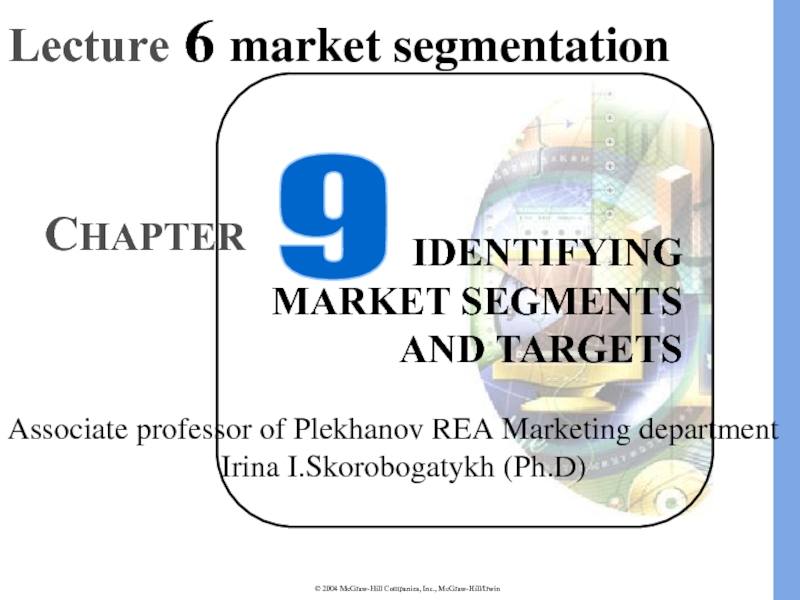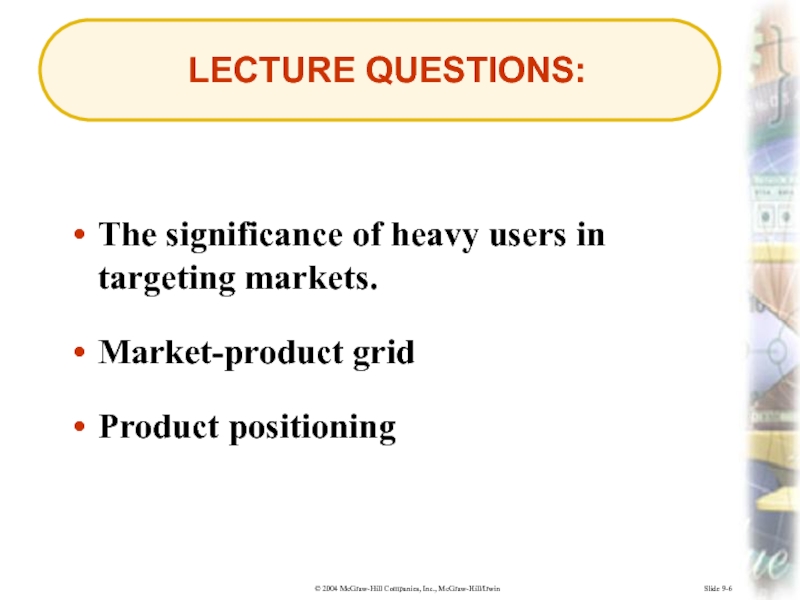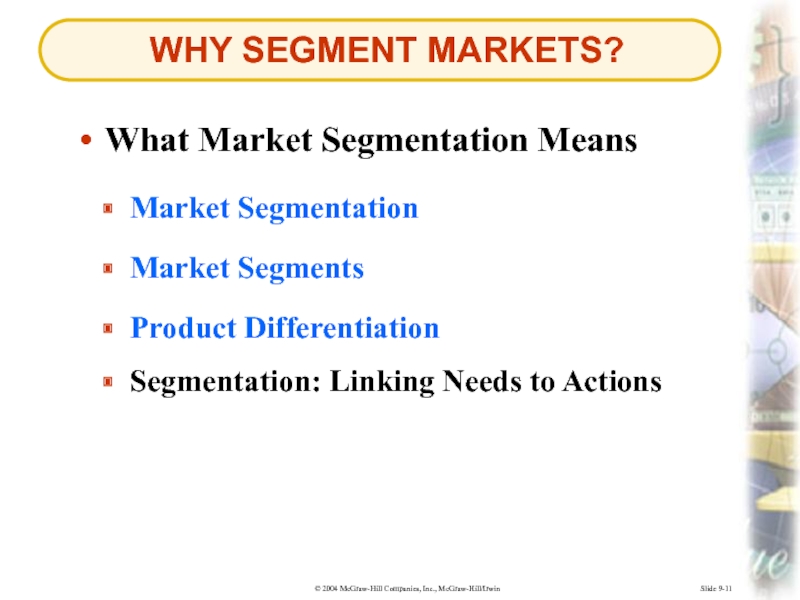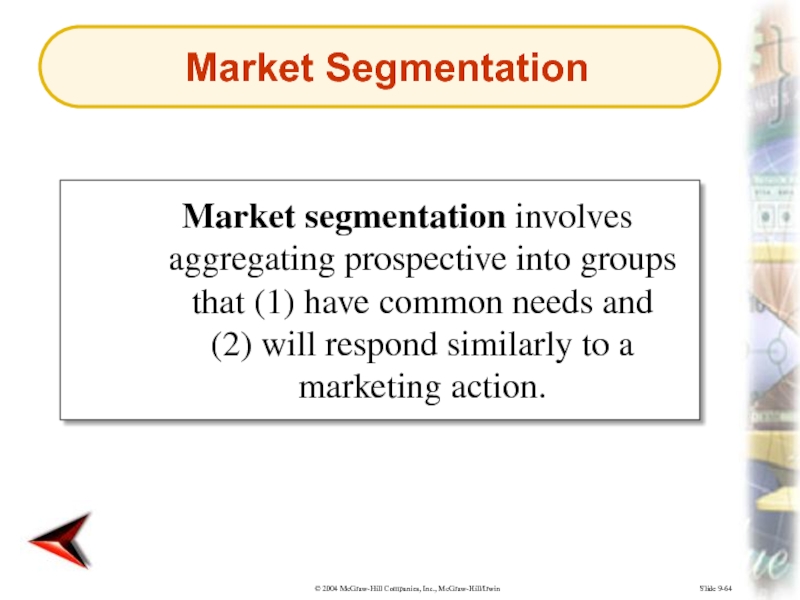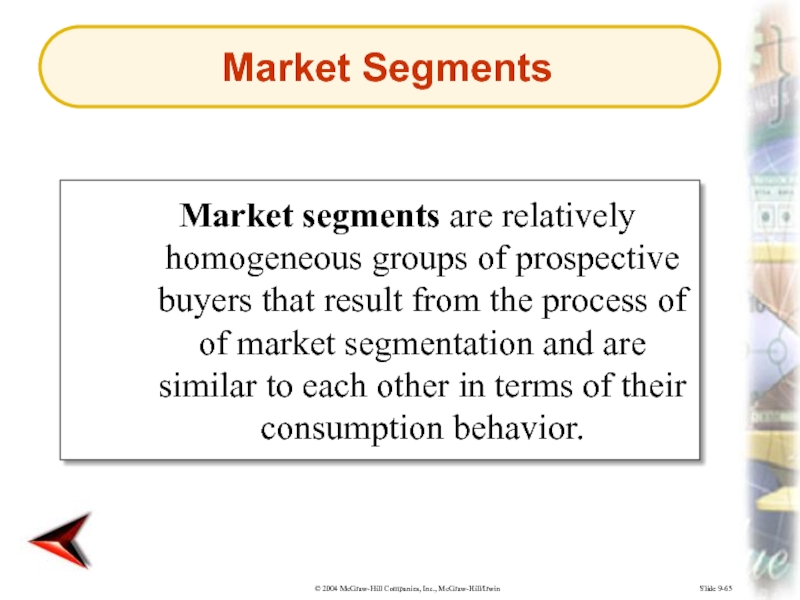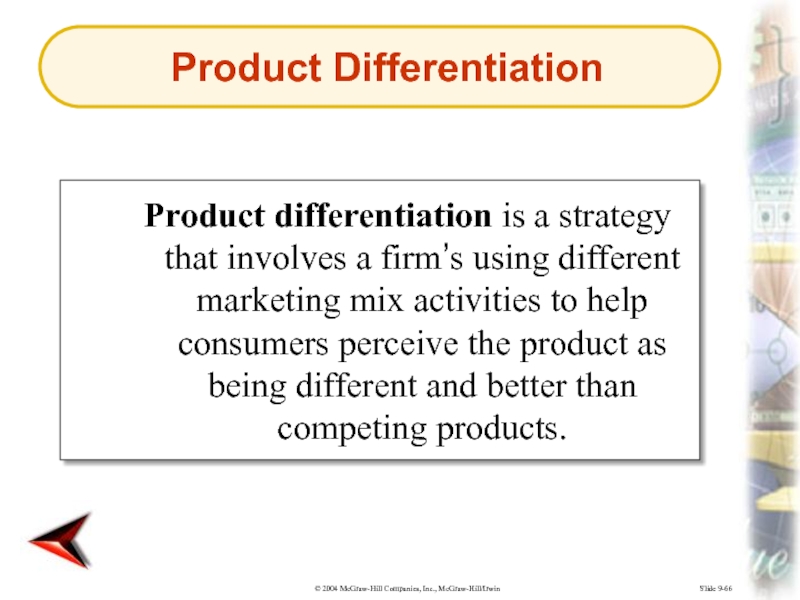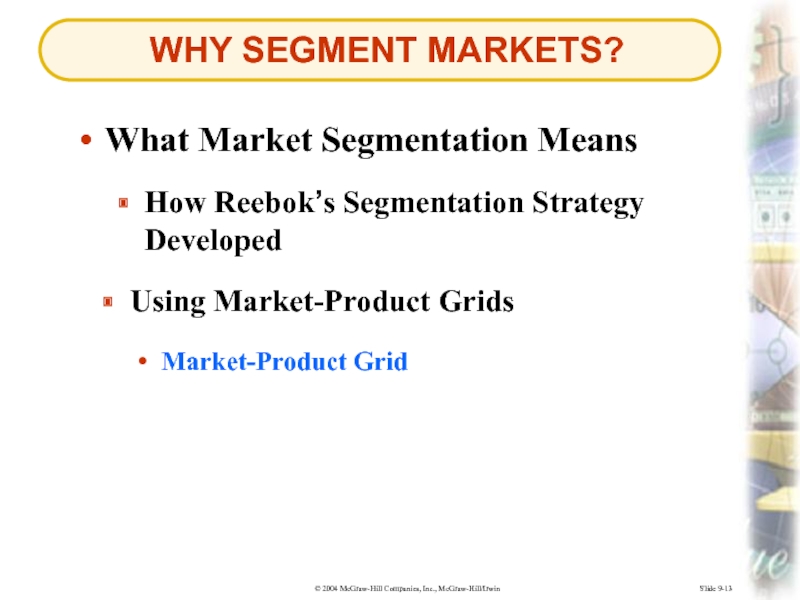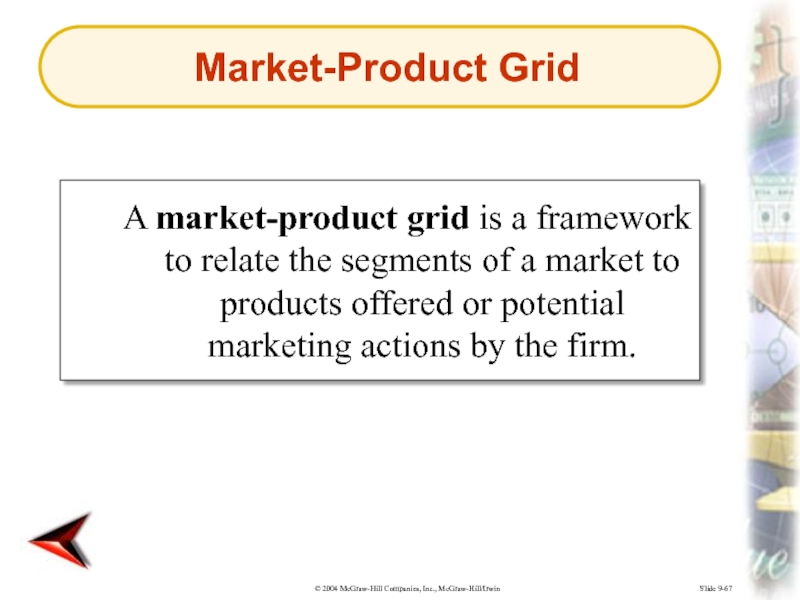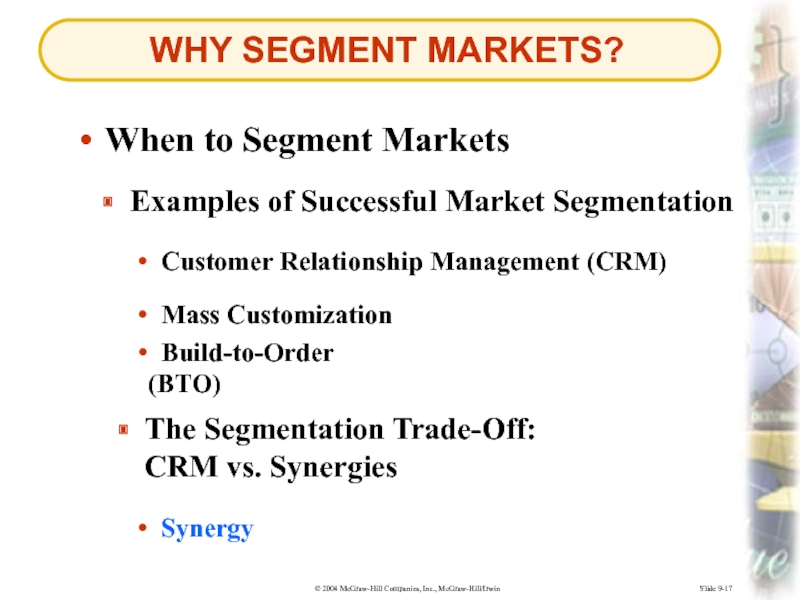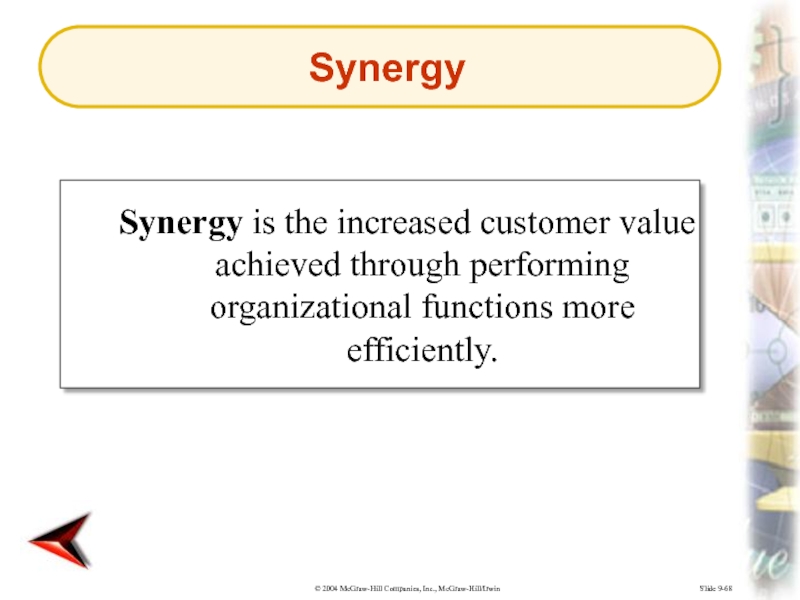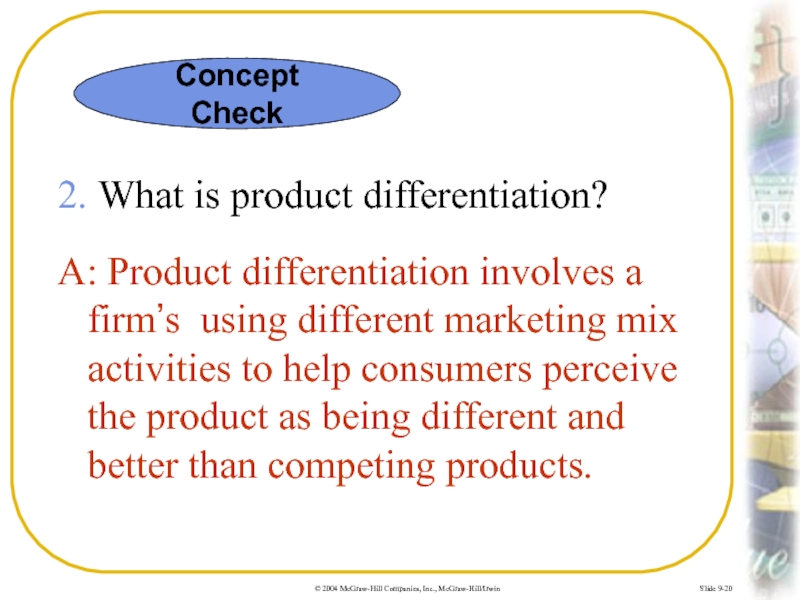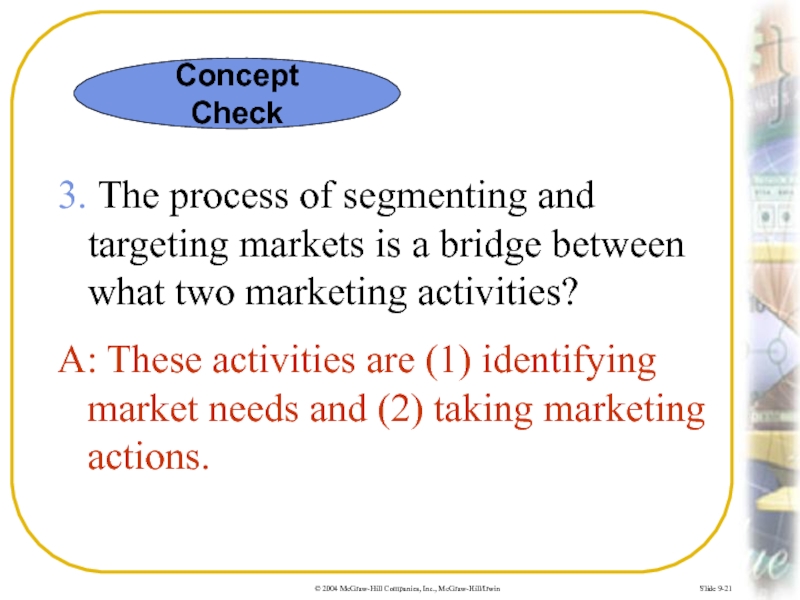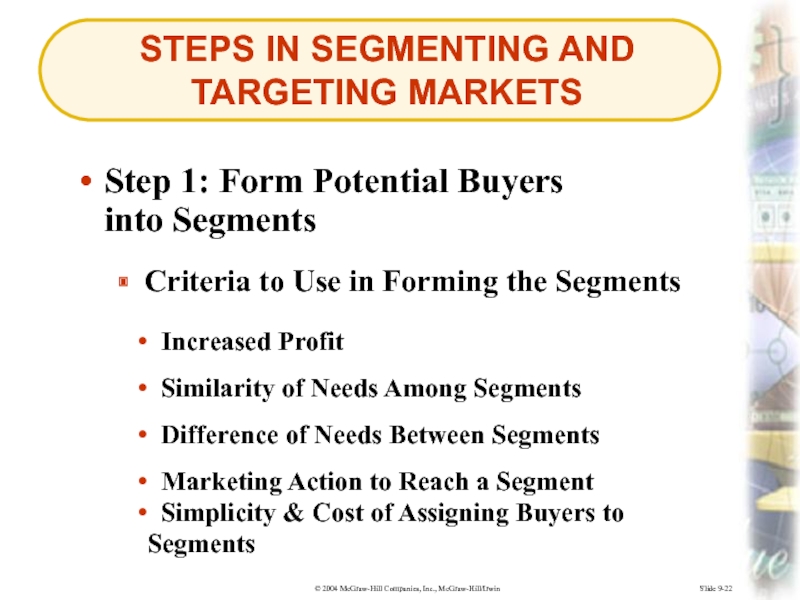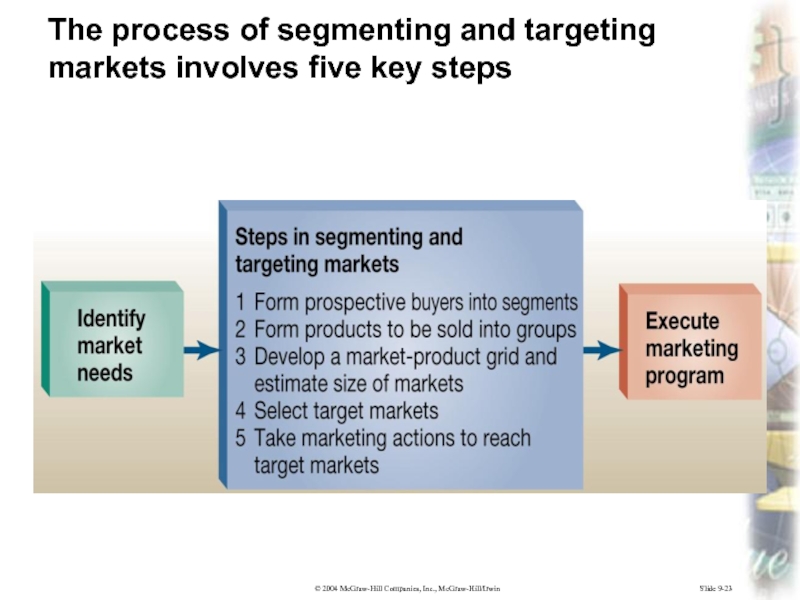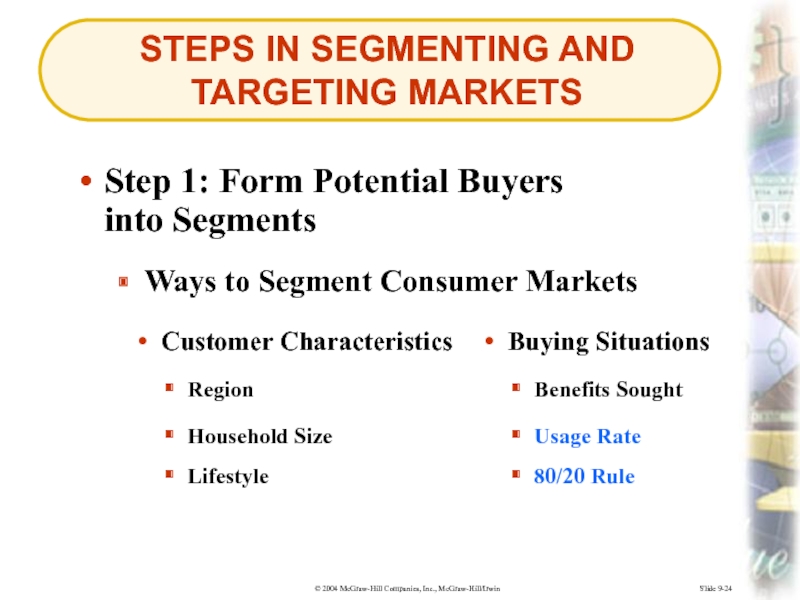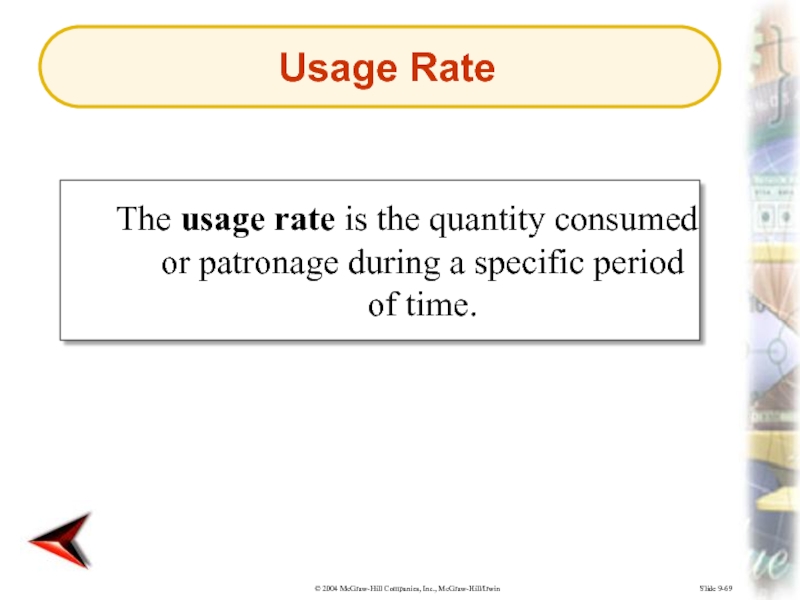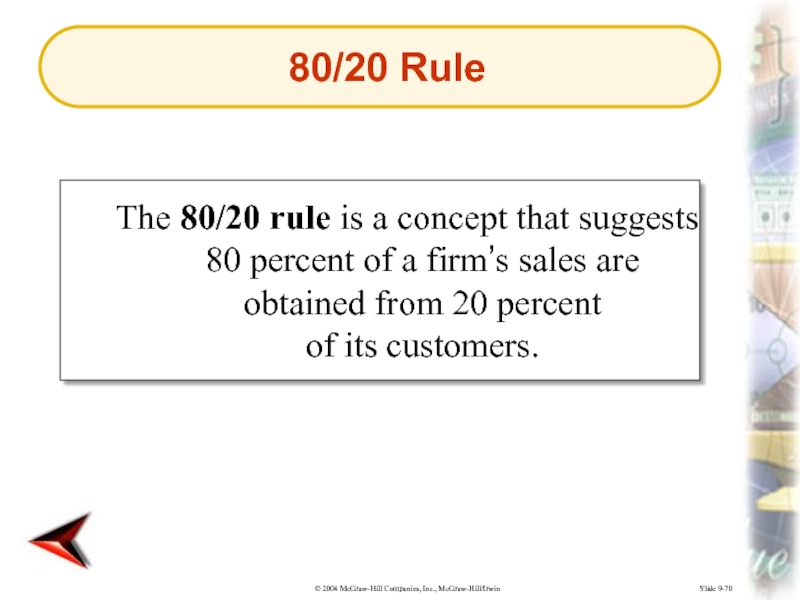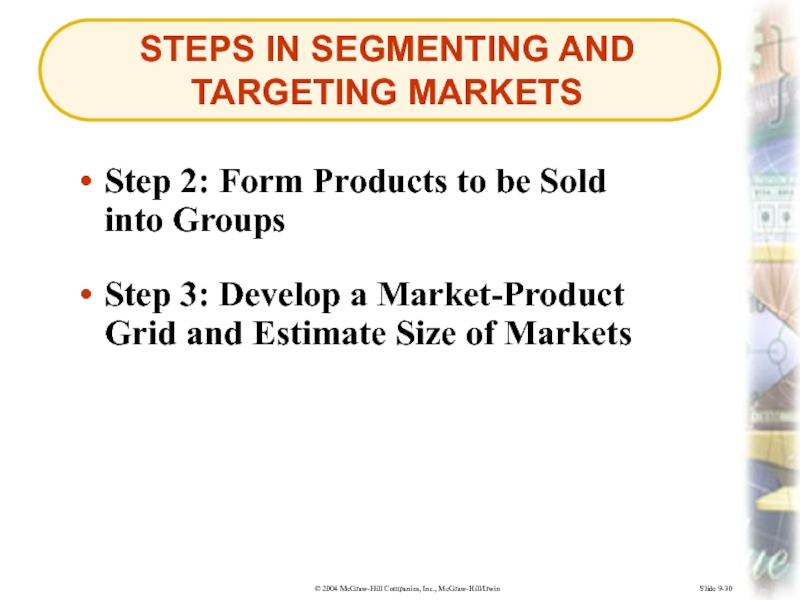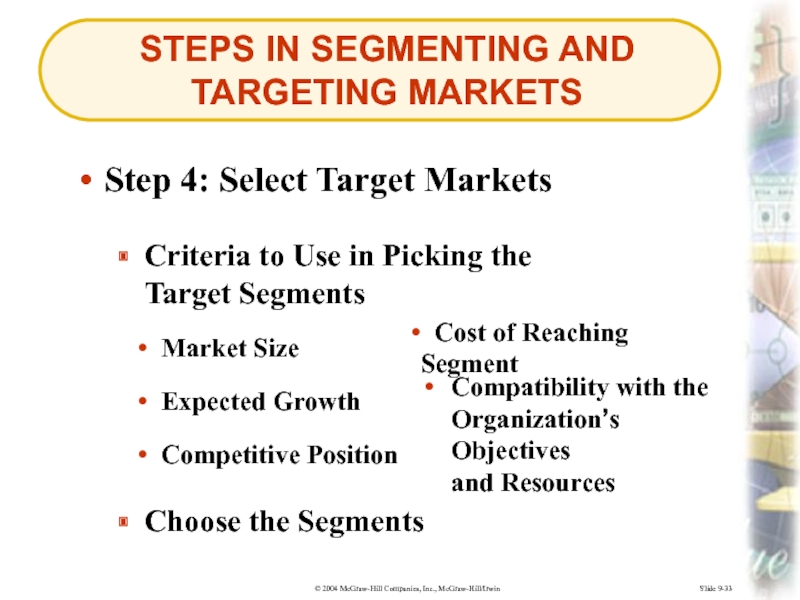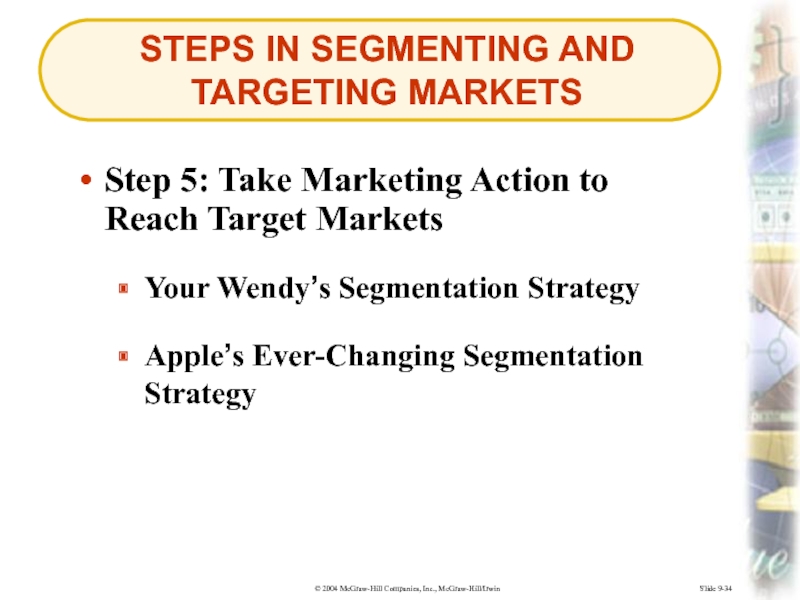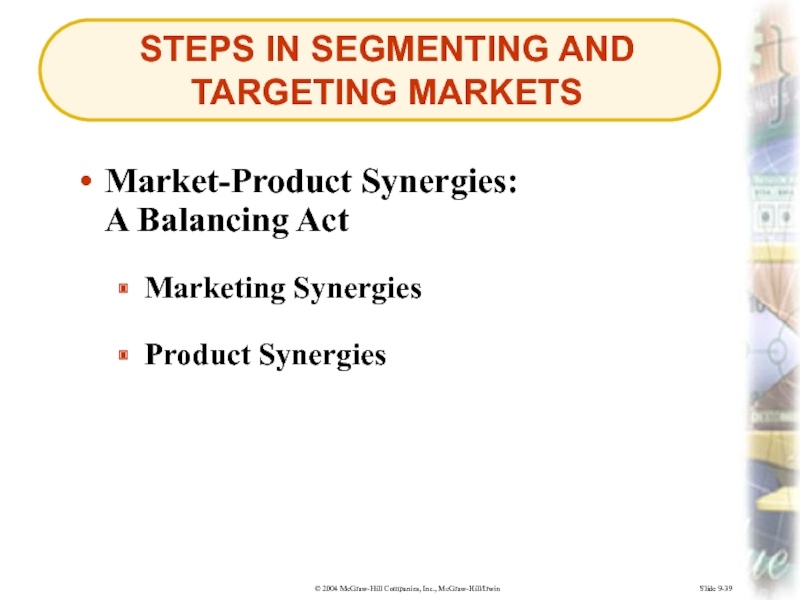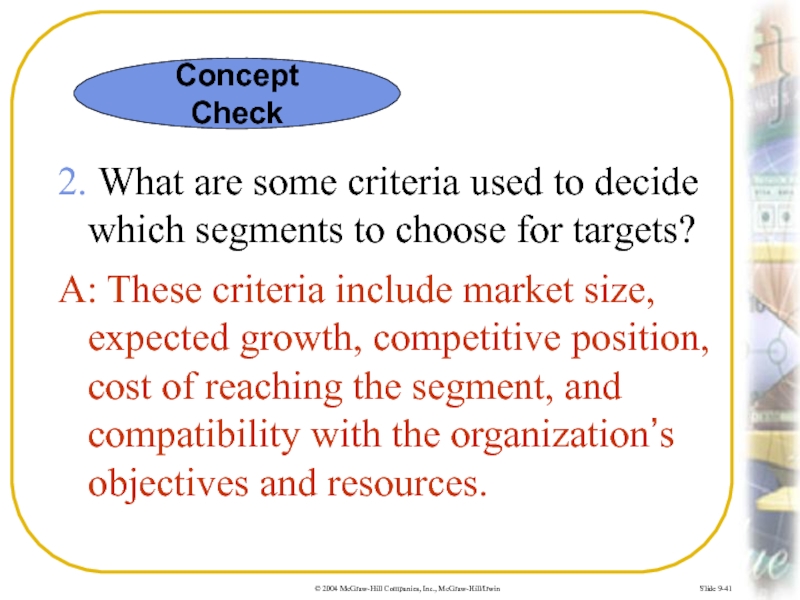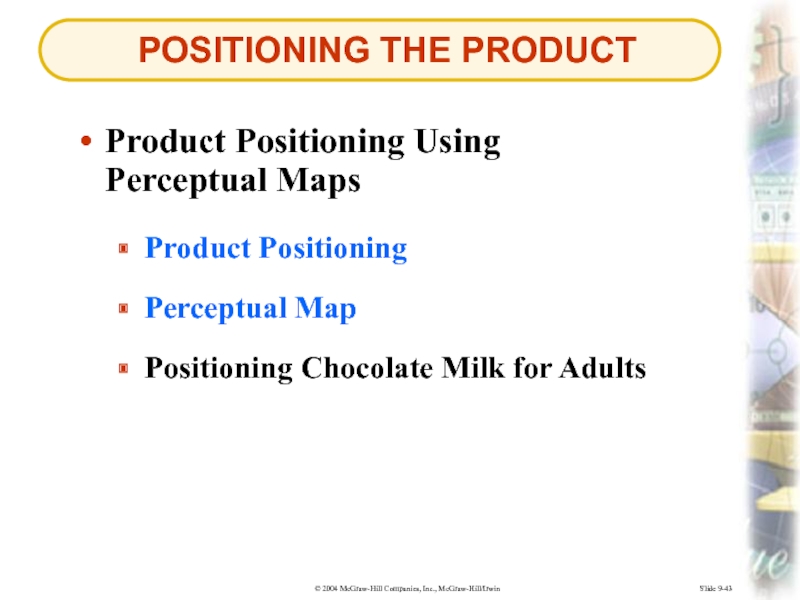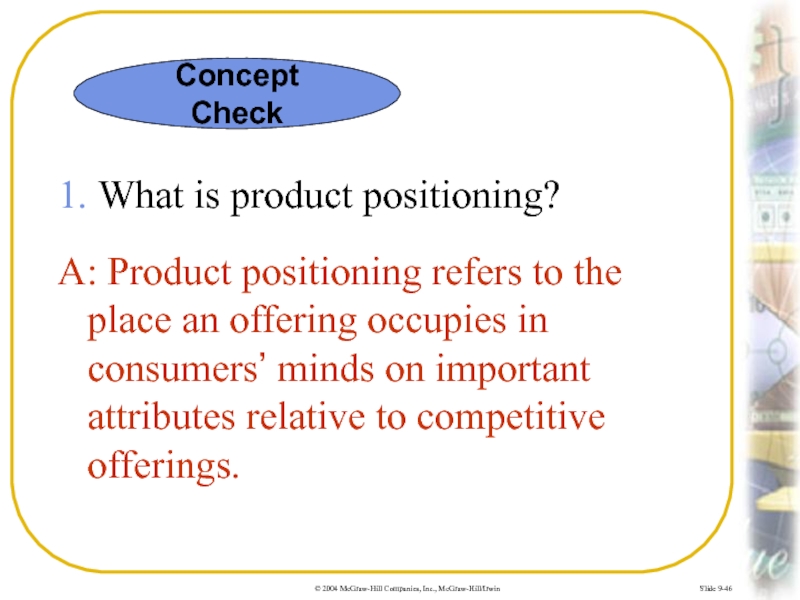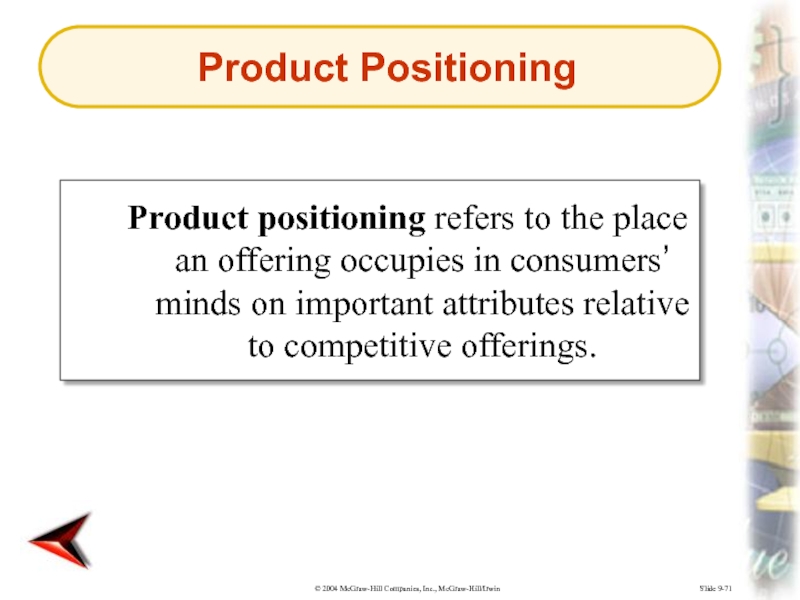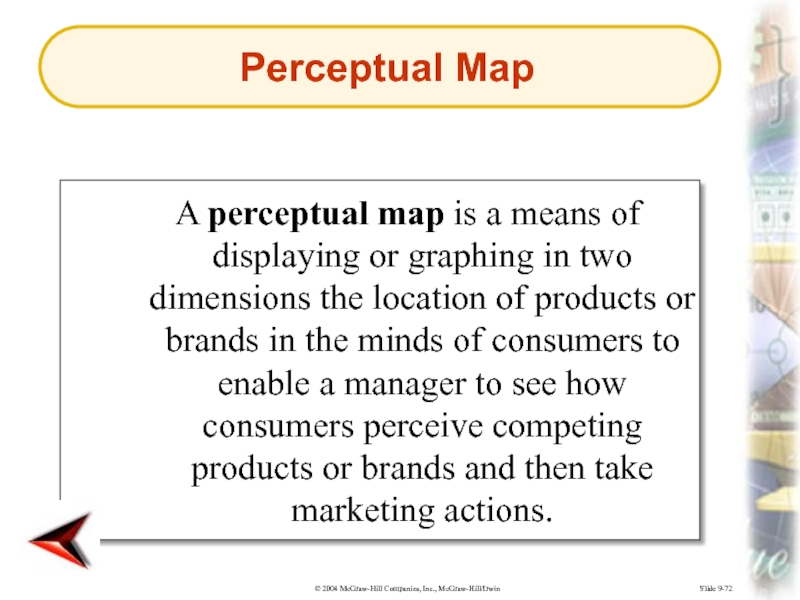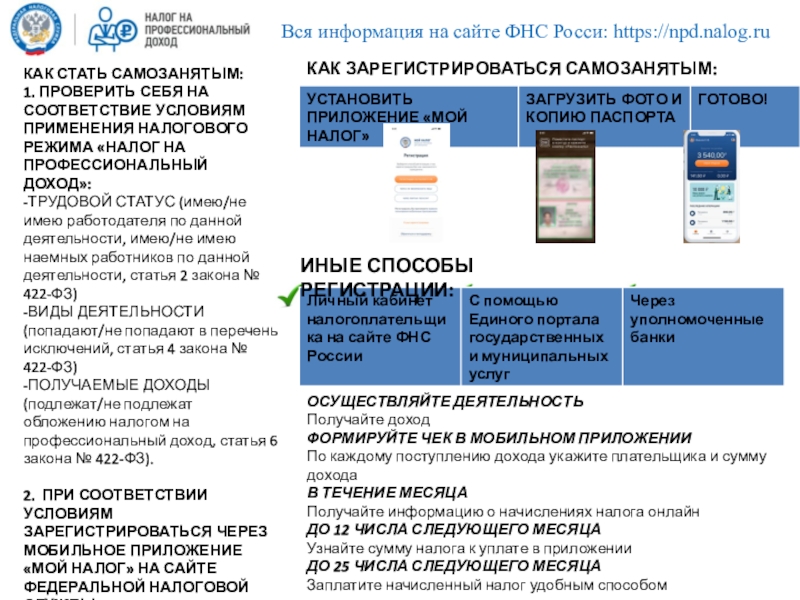Разделы презентаций
- Разное
- Английский язык
- Астрономия
- Алгебра
- Биология
- География
- Геометрия
- Детские презентации
- Информатика
- История
- Литература
- Математика
- Медицина
- Менеджмент
- Музыка
- МХК
- Немецкий язык
- ОБЖ
- Обществознание
- Окружающий мир
- Педагогика
- Русский язык
- Технология
- Физика
- Философия
- Химия
- Шаблоны, картинки для презентаций
- Экология
- Экономика
- Юриспруденция
IDENTIFYING MARKET SEGMENTS AND TARGETS C HAPTER Lecture 6 market
Содержание
- 1. IDENTIFYING MARKET SEGMENTS AND TARGETS C HAPTER Lecture 6 market
- 2. Slide 9-5LECTURE QUESTIONS:Definition of Market segmentation Different factors used to segment consumer and organizational markets.
- 3. Slide 9-6LECTURE QUESTIONS:The significance of heavy users in targeting markets.Market-product grid Product positioning
- 4. WHY SEGMENT MARKETS?Slide 9-11What Market Segmentation Means
- 5. Slide 9-64Market segmentation involves aggregating prospective into
- 6. Slide 9-65Market segments are relatively homogeneous groups
- 7. Slide 9-66Product differentiation is a strategy that
- 8. Slide 9-12Market segmentation links market needs to an organization’s marketing program
- 9. Slide 9-13WHY SEGMENT MARKETS? Using Market-Product GridsWhat Market Segmentation MeansHow Reebok’s Segmentation Strategy Developed Market-Product Grid
- 10. Slide 9-67A market-product grid is a framework
- 11. Slide 9-17WHY SEGMENT MARKETS? Examples of Successful
- 12. Slide 9-68Synergy is the increased customer value achieved through performing organizational functions more efficiently.Synergy
- 13. Slide 9-19 1. Market segmentation involves aggregating
- 14. Slide 9-20 2. What is product differentiation?A:
- 15. Slide 9-21 3. The process of segmenting
- 16. Slide 9-22STEPS IN SEGMENTING AND TARGETING MARKETSStep
- 17. Slide 9-23The process of segmenting and targeting markets involves five key steps
- 18. Slide 9-24STEPS IN SEGMENTING AND TARGETING MARKETSStep
- 19. Slide 9-69The usage rate is the quantity
- 20. Slide 9-70The 80/20 rule is a concept
- 21. Slide 9-28STEPS IN SEGMENTING AND TARGETING MARKETSStep
- 22. Slide 9-30STEPS IN SEGMENTING AND TARGETING MARKETSStep
- 23. Slide 9-33STEPS IN SEGMENTING AND TARGETING MARKETSStep
- 24. Slide 9-34STEPS IN SEGMENTING AND TARGETING MARKETSStep
- 25. Slide 9-39STEPS IN SEGMENTING AND TARGETING MARKETSMarket-Product Synergies: A Balancing ActMarketing SynergiesProduct Synergies
- 26. Slide 9-40 1. What are some of
- 27. Slide 9-41 2. What are some criteria
- 28. Slide 9-42 3. Why is usage rate
- 29. Slide 9-43POSITIONING THE PRODUCTProduct Positioning Using Perceptual MapsProduct PositioningPerceptual MapPositioning Chocolate Milk for Adults
- 30. Slide 9-46 1. What is product positioning?A:
- 31. Slide 9-47 2. Why do marketers use
- 32. Slide 9-71Product positioning refers to the place
- 33. Slide 9-72A perceptual map is a means
- 34. Скачать презентанцию
Слайды и текст этой презентации
Слайд 1IDENTIFYING MARKET SEGMENTS AND TARGETS
CHAPTER
Lecture 6 market segmentation
Associate professor
of Plekhanov REA Marketing department
Слайд 2Slide 9-5
LECTURE QUESTIONS:
Definition of Market segmentation
Different factors used to
segment consumer and organizational markets.
Слайд 3Slide 9-6
LECTURE QUESTIONS:
The significance of heavy users in targeting markets.
Market-product
grid
Product positioning
Слайд 4WHY SEGMENT MARKETS?
Slide 9-11
What Market Segmentation Means
Market Segmentation
Market
Segments
Product Differentiation
Segmentation: Linking Needs to Actions
Слайд 5Slide 9-64
Market segmentation involves aggregating prospective into groups that (1)
have common needs and (2) will respond similarly to a marketing
action.Market Segmentation
Слайд 6Slide 9-65
Market segments are relatively homogeneous groups of prospective buyers
that result from the process of of market segmentation and
are similar to each other in terms of their consumption behavior.Market Segments
Слайд 7Slide 9-66
Product differentiation is a strategy that involves a firm’s
using different marketing mix activities to help consumers perceive the
product as being different and better than competing products.Product Differentiation
Слайд 9Slide 9-13
WHY SEGMENT MARKETS?
Using Market-Product Grids
What Market Segmentation Means
How
Reebok’s Segmentation Strategy
Developed
Market-Product Grid
Слайд 10Slide 9-67
A market-product grid is a framework to relate the
segments of a market to products offered or potential marketing
actions by the firm.Market-Product Grid
Слайд 11Slide 9-17
WHY SEGMENT MARKETS?
Examples of Successful Market Segmentation
Build-to-Order
(BTO)
Mass Customization
When to Segment Markets
The Segmentation Trade-Off:
CRM vs. Synergies
Synergy Customer Relationship Management (CRM)
Слайд 12Slide 9-68
Synergy is the increased customer value achieved through performing
organizational functions more efficiently.
Synergy
Слайд 13Slide 9-19
1. Market segmentation involves aggregating prospective buyers into
groups that have two key characteristics. What are they?
A: The
groups should (1) have common needs and (2) respond similarly to a marketing action.Concept Check
Слайд 14Slide 9-20
2. What is product differentiation?
A: Product differentiation involves
a firm’s using different marketing mix activities to help consumers
perceive the product as being different and better than competing products.Concept Check
Слайд 15Slide 9-21
3. The process of segmenting and targeting markets
is a bridge between what two marketing activities?
A: These activities
are (1) identifying market needs and (2) taking marketing actions.Concept Check
Слайд 16Slide 9-22
STEPS IN SEGMENTING AND
TARGETING MARKETS
Step 1: Form Potential Buyers
into
Segments
Criteria to Use in Forming the Segments
Increased Profit
Similarity
of Needs Among Segments Difference of Needs Between Segments
Marketing Action to Reach a Segment
Simplicity & Cost of Assigning Buyers to Segments
Слайд 18Slide 9-24
STEPS IN SEGMENTING AND TARGETING MARKETS
Step 1: Form Potential
Buyers
into Segments
Ways to Segment Consumer Markets
Customer Characteristics
Region
Buying
Situations Household Size
Lifestyle
Benefits Sought
Usage Rate
80/20 Rule
Слайд 19Slide 9-69
The usage rate is the quantity consumed or patronage
during a specific period of time.
Usage Rate
Слайд 20Slide 9-70
The 80/20 rule is a concept that suggests 80
percent of a firm’s sales are obtained from 20 percent of
its customers.80/20 Rule
Слайд 21Slide 9-28
STEPS IN SEGMENTING AND TARGETING MARKETS
Step 1: Form Potential
Buyers
into Segments
Variables to Use in Forming Segments
Ways to Segment Organizational
Markets Location
NAICS Code
Number of Employees
Benefits Sought
Слайд 22Slide 9-30
STEPS IN SEGMENTING AND TARGETING MARKETS
Step 2: Form Products
to be Sold into Groups
Step 3: Develop a Market-Product Grid
and Estimate Size of MarketsСлайд 23Slide 9-33
STEPS IN SEGMENTING AND TARGETING MARKETS
Step 4: Select Target
Markets
Criteria to Use in Picking the
Target Segments
Choose the Segments
Market
Size Expected Growth
Cost of Reaching Segment
Compatibility with the
Organization’s Objectives
and Resources
Competitive Position
Слайд 24Slide 9-34
STEPS IN SEGMENTING AND TARGETING MARKETS
Step 5: Take Marketing
Action to Reach Target Markets
Your Wendy’s Segmentation Strategy
Apple’s Ever-Changing Segmentation
Strategy
Слайд 25Slide 9-39
STEPS IN SEGMENTING AND TARGETING MARKETS
Market-Product Synergies:
A Balancing Act
Marketing
Synergies
Product Synergies
Слайд 26Slide 9-40
1. What are some of the variables used
to segment consumer markets?
A: These variables include demographic (gender, age,
etc.), geographic (region, city size, etc.), socioeconomic (income, education, etc.), psychographic (lifestyle, etc.), benefits sought (features, quality, etc.) and usage rate (light/medium/heavy user).Concept Check
Слайд 27Slide 9-41
2. What are some criteria used to decide
which segments to choose for targets?
A: These criteria include market
size, expected growth, competitive position, cost of reaching the segment, and compatibility with the organization’s objectives and resources.Concept Check
Слайд 28Slide 9-42
3. Why is usage rate important in segmentation
studies?
A: Usage rate is the quantity consumed during a specific
time period and varies among different customer groups. In many cases, 80% of a firm’s sales are obtained from 20% of its customers—the “heavy users.” As a result, these target consumers are the most important to the firm.Concept Check
Слайд 29Slide 9-43
POSITIONING THE PRODUCT
Product Positioning Using Perceptual Maps
Product Positioning
Perceptual Map
Positioning
Chocolate Milk for Adults
Слайд 30Slide 9-46
1. What is product positioning?
A: Product positioning refers
to the place an offering occupies in consumers’ minds on
important attributes relative to competitive offerings.Concept Check
Слайд 31Slide 9-47
2. Why do marketers use perceptual maps in
product positioning decisions?
A: Marketers use perceptual maps to display in
two dimensions the location of their and competing products or brands to see how consumers perceive them and then take marketing actions.Concept Check
Слайд 32Slide 9-71
Product positioning refers to the place an offering occupies
in consumers’ minds on important attributes relative to competitive offerings.
Product
PositioningСлайд 33Slide 9-72
A perceptual map is a means of displaying or
graphing in two dimensions the location of products or brands
in the minds of consumers to enable a manager to see how consumers perceive competing products or brands and then take marketing actions.Perceptual Map
